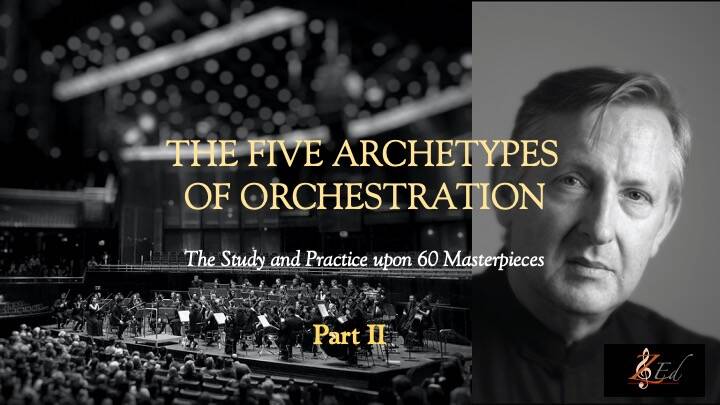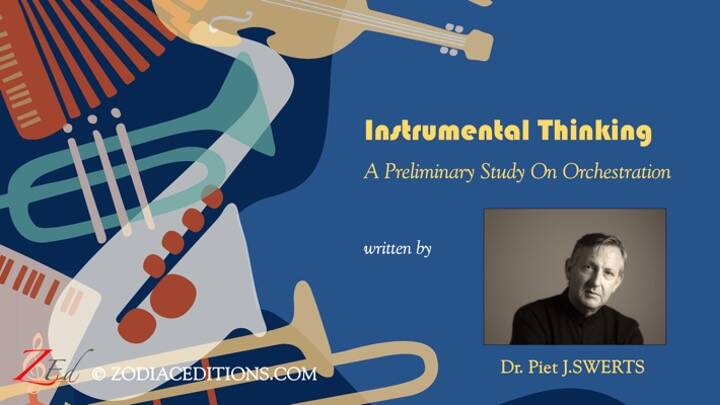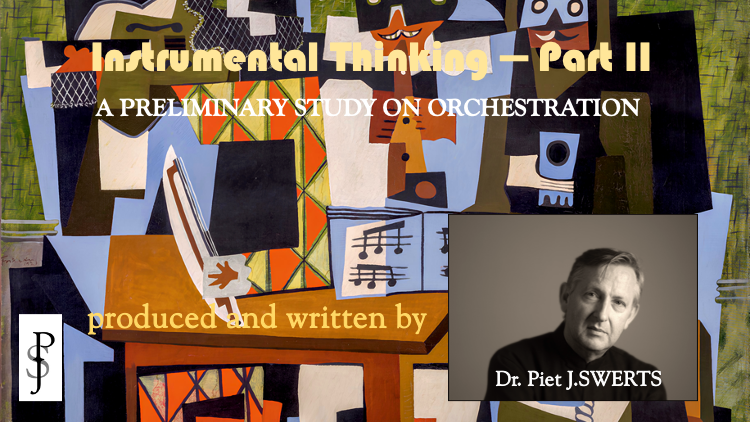
We have organized this course very transparently in the main orchestration procedures with well-known excerpts from Western music-literature but also related to own compositions. Therefore, we have divided the entirety of the course into five major parts. Each part will be dedicated to exactly one of the five archetypes of orchestration. Each part will thus contain 12 lessons focused on that particular aspect. The whole course will cover at least 60 examples carefully discussed and analyzed. The assignments are directly related to these fragments. All relevant aspects and techniques will be covered in detail, offering you the opportunity to try everything out for yourself to gain efficient insight and become a true professional. Worksheets and reductions has been elaborated, solutions provided, but also applications into one’s own contemporary practice illustrate the relevance of traditional orchestral principles into modern classical music compositions. By imitating and emulating the masters, you will become by time a master yourself. We have carefully selected excerpts in different styles, from Mozart, Beethoven, Grieg, Holst, Bizet, Debussy, Stravinsky, Bartok and myself. In the downloadable resources are 95 items provided: the whole spoken commentaries in English are completely written out and can be downloaded to gain more understanding of each lesson. We are truly convinced that this method of working, copying, imitating, emulating the masters, which has already often proven in the past that this was the method to learn craftsmanship, will help you further develop as an artist.
What you’ll learn
- Become a master by imitating and emulating the great masterpieces
- You will gain deeper insight into the mechanisms of orchestration by copying masterpieces by ear and afterwards compare your result with it.
- You will become more aware of balance issues in orchestration
- By making all assignments structured according to the five archetypes, you will orchestrate much more consciously in an artistic way
- By orchestrating masterpieces by listening first, you will analyse their logic more deeply and learn to orchestrate much more consistently.
- By working out all 60 assignments, you are going to greatly enhance your imagination of the quality and possibilities of the different timbres
- This method of imitation and emulation has long been tried and tested and will turn you into a more professional composer or orchestrator.
- By consciously working on the five basic types of orchestration, you will start orchestrating much more efficiently
- You will improve your inner hearing by studying excerpts of masterpieces
- You will experience how your instructor as a composer himself applies the archetypes of orchestration in comparison with the great masters
Are there any course requirements or prerequisites?
- This course already requires basic instrumental knowledge. A helpful reference is The Study of Orchestration by S. Adler. Some experience in instrumentation is a plus. Worksheets are provided for each lesson. It is recommended to work out the assignments by hand and not with software like Finale or Sibelius..
Who this course is for:
- Ideal for music students, young composers, arrangers, orchestrators and music lovers of music theory from intermediate to more advanced levels.


This course is an excellent preliminary study, well suited as a preparation for Dr. Swerts' Orchestration Course, "The Five Archetypes of Orchestration," Parts I, II, and III-V will follow later. Here, though, with only one single folk song as a model, various instrumental presentations, possibilities, and techniques will be explained and demonstrated, modifying the original model into a new musical context as a consequence of the chosen instrument. In this first part, all the families of the orchestra will be presented and discussed one by one. In the second part, we will proceed with instrumental combinations of the same families, but as duos, trios, and quartets, and various treatments of the string orchestra as well. Moreover, each model will each time rely on the original model of the folksong; as such, you will notice the immense difference in textures due to the choice of different instrument combinations. Some famous examples from the orchestral literature are also applied where necessary and possible. After completing both courses (Instrumental Thinking Parts I and II), you will have a much clearer idea of the characteristics of each instrument type, which will allow you to go deeper into the basic elements of orchestration, as illustrated much more in Dr. Swerts course mentioned above. There, we go deeper into the different textures, where many combinations will be explained via the canon of Western orchestral literature and with assignments and worksheets.
What you’ll learn
- We handle tools to you how to treat simple lines into instrumental parts for different instrument families.
- We deal with each characteristic of each instrument family and experience its implications into varied writing.
- We make difference between treatment of a single string instrument and instrument string groups.
- This study offers a deeper preparation into the art of orchestration.
- Additional information about playing techniques, notation and ranges are incorporated as well.
Are there any course requirements or prerequisites?
- Basic knowledge of music theory is required.
Who this course is for:
- This course is intended both for amateur and professional musicians, music students, performers, composers and conductors. It tend to offer deeper musical insights into the mechanism of composition and music.

In Part 2, we continue the exploration of instrumental thinking within the different orchestral groups, we go through the groups following the same order and arrangement as in Part 1. There, we covered the solo instrumental variations for each instrument and will now explore what kind of musical and compositional interaction occurs when we start combining multiple instruments from duo to trio to quartet combinations as well. Although there are so to speak only nine lessons, each lesson, though is very extended and dives deeper into all details of each model explained. Also the different treatments of the string orchestra will deserve much more attention . In the downloadable features, the full spoken text is edited completely and we have added for each model a QR Code so that you will be able to listen independently to every tracks of all models. It is highly recommendable to commence first with the first part of this preliminary course to understand fully the second part. We are convinced that by gradually following the first and second part of Instrumental Thinking, you will be well prepared to start the serie of The Five Archetypes of Orchestration. In Instrumental thinking no assignments are provided, but you are advised to try to follow up the given models by selecting yourself a given melody suitable for transformations and imitating and emulating the models exposed in this course: in that manner, you might more deeply understand and gain insight into the mechanism of arranging, orchestrating, transcribing, and composing.

